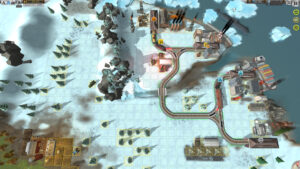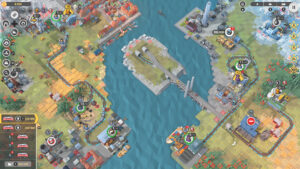Train Valley contrasted to its sequel
Train Valley 2: Seldom have I seen a sequel so thoroughly change the fundamental character of a game without altering its basic gameplay.
 That gameplay consists mainly of laying tracks to join stations. Games based on that idea run a spectrum from abstract puzzle games like Trainyard, to realistic simulators like Railworks, and Train Valley is toward the abstract end of that, but not quite as far out as Mini Metro. You have fanciful toy-looking locomotives on a grid of big chunky squares, dotted with obstacles and color-coded stations. Trains randomly materialize at the stations, and if you get them to their destinations in good time, you earn money that you use to build more tracks to cope with increasing demands on your network and the gradual appearance of additional stations. Your chief enemy is the constraints of the grid: tracks can only turn 45 degrees per tile, and each tile can contain only one switch or crossing. And on top of that, it’s prudent to have redundancy, to keep any trains going from point A to point B from blocking trains departing point B. Sometimes you wind up making a complicated web of junctions to cope with the constraints, and once you have that, it’s very easy to leave something switched the wrong way and send a train to the wrong place. The scale goes together with the art style to make it all look and feel like playing with a toy train set: sometimes the distance between stations is barely longer than the trains running on them.
That gameplay consists mainly of laying tracks to join stations. Games based on that idea run a spectrum from abstract puzzle games like Trainyard, to realistic simulators like Railworks, and Train Valley is toward the abstract end of that, but not quite as far out as Mini Metro. You have fanciful toy-looking locomotives on a grid of big chunky squares, dotted with obstacles and color-coded stations. Trains randomly materialize at the stations, and if you get them to their destinations in good time, you earn money that you use to build more tracks to cope with increasing demands on your network and the gradual appearance of additional stations. Your chief enemy is the constraints of the grid: tracks can only turn 45 degrees per tile, and each tile can contain only one switch or crossing. And on top of that, it’s prudent to have redundancy, to keep any trains going from point A to point B from blocking trains departing point B. Sometimes you wind up making a complicated web of junctions to cope with the constraints, and once you have that, it’s very easy to leave something switched the wrong way and send a train to the wrong place. The scale goes together with the art style to make it all look and feel like playing with a toy train set: sometimes the distance between stations is barely longer than the trains running on them.
 Train Valley 2 shifts towards realism. Mainly it does this by adding more ways to affect and be affected by terrain. You can build bridges and tunnels, at great expense. There are slopes, which you can build tracks to ascend or descend but not running along laterally. There are steeper slopes that are just plain impassible. This variability makes it easy for the designers to make the kind of congestion that dominated the first game local to a part of the playfield. Distance is now a big problem. The tiles are smaller, or, equivalently, the levels are larger, and trains can take a significant amount of time to get where they’re going. To intensify this, you have a limited number of trains that can be running at one time. You can purchase more, or upgrade them to run faster, but this comes at a considerable cost, which can delay the purchase of essential bridges and tunnels.
Train Valley 2 shifts towards realism. Mainly it does this by adding more ways to affect and be affected by terrain. You can build bridges and tunnels, at great expense. There are slopes, which you can build tracks to ascend or descend but not running along laterally. There are steeper slopes that are just plain impassible. This variability makes it easy for the designers to make the kind of congestion that dominated the first game local to a part of the playfield. Distance is now a big problem. The tiles are smaller, or, equivalently, the levels are larger, and trains can take a significant amount of time to get where they’re going. To intensify this, you have a limited number of trains that can be running at one time. You can purchase more, or upgrade them to run faster, but this comes at a considerable cost, which can delay the purchase of essential bridges and tunnels.
Most of all, though, the trains in Train Valley 2 are purposeful. It’s not just a matter of “Train at blue station arbitrarily wants to go to orange station”. Rather, stations are associated with commodities. Each level has one or more towns, which produce workers at a steady rate and which have icons indicating certain needs, like “this town requires 12 copper ingots, 16 books, and 6 airplanes”. Fulfilling those needs is the goal of the level. Other stations will take specific resources to produce others: workers + grain = cows, for example. (Like all resources, workers are absorbed in these recipes.) It’s a bit like Hero of the Kingdom but with trains. And it has a profound effect on how the game feels. The first Train Valley was all about reacting to events. Train Valley 2 is all about planning. The first thing you do on loading a level is scan the map to see where the towns are, and where the resources that require nothing but workers are. The hierarchy of dependencies is like a story, a sequence of events with an optimal ordering that gets you everything you need within a par time.
 Comments(0)
Comments(0)